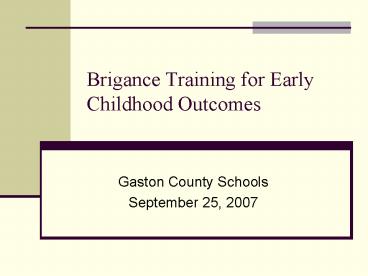Brigance Training for Early Childhood Outcomes - PowerPoint PPT Presentation
1 / 15
Title:
Brigance Training for Early Childhood Outcomes
Description:
Can serve as both a diagnostic instrument and as a criterion referenced ... Feeding/Eating, Undressing, Dressing, Unfastening, Fastening, Toileting, Bathing, ... – PowerPoint PPT presentation
Number of Views:913
Avg rating:3.0/5.0
Title: Brigance Training for Early Childhood Outcomes
1
Brigance Training for Early Childhood Outcomes
- Gaston County Schools
- September 25, 2007
2
Brigance IED-II
- Inventory of Early DevelopmentII
- For children from birth to developmental age of 6
years. - Can serve as both a diagnostic instrument and as
a criterion referenced assessment
3
Anchor Assessment
- Gaston County Schools will be using the Brigance
IED-II as its anchor assessment tool for the
Early Childhood Outcomes ratings. - The Brigance will need to be administered within
60 days of entering preschool 619 services and
again prior to the childs exit from preschool
services.
4
Aligning Assessment with Outcomes
- Outcome 1 Positive Social-Emotional Skills
- Outcome 2 Acquiring and Using Knowledge Skills
- Outcome 3 Taking Appropriate Action to Meet Needs
- Brigance Section G
- Brigance Section F
- Brigance Section D
5
Administration
- It is important to remember that this is not a
standardized assessment. - Does not require rigid administration procedures.
6
Recording Procedures and Color Code
- Recording
- -Circle responses for skills mastered.
- -Underline items child has not yet mastered.
- Color Code
- Each evaluation is recorded in a different color
to track progress. - 1st-pencil, 2nd-Blue
7
Starting Points
- Select the most appropriate skill level within
the sequence. - Evaluate the data you have about the child to
estimate the developmental age level. - Once you have an approximate developmental age,
you may want to drop back to the previous start
point to initiate the assessment. - Ex. If dev. age is 3 years, you may want to drop
back to the start point of 2-6 to ensure success.
8
Section D Self-Help Skills
- Covers 8 self-help topics
- Feeding/Eating, Undressing, Dressing,
Unfastening, Fastening, Toileting, Bathing, and
Grooming - Assessment Methods
- Parent Interview
- Formal/Informal Observation
- Discontinue subsection after 3 consecutive
failures.
9
Section F General Knowledge and Comprehension
- Skills measured include response to books, body
parts, colors, shapes, quantitative concepts,
directional concepts, etc. - Assessment Methods
- Parent Interview
- Formal/Informal Observations
- Child Performance
10
Section F Discontinue Rules
- Discontinue rules vary by subsection
- 3 consecutive failures
- Response to Books, Body Parts, Knows Use of
Objects - 2 consecutive failures
- Colors, Shape Concepts, Quantitative Concepts,
Directional Concepts, Classifying, Knows What to
Do in Different Situations
11
Section F Multiple Levels
- Three areas within Section F have multiple
levels body parts, colors, and shape concepts. - Body Parts receptive and expressive
- Colors matches, points to, names
- Shape Concepts matches, points to, names
12
Multiple Levels (cont.)
- Begin administration with the higher level skills
(as appropriate). - Give credit for lower-level skills whenever the
child demonstrates mastery at a higher level. - For example, if the child names red, give
credit for the lower-level skills matching and
pointing without actually administering them.
13
Section G Social Emotional Development
- Consists of three parts
- General Social and Emotional Development
- Play Skills and Behaviors
- Initiative and Engagement Skills and Behaviors
- Assessment Methods
- Parent Interview
- Formal/Informal Methods
- Discontinue after 3 consecutive failures.
14
Transfer Scores to COSF
- Record developmental age scores from Sections
D,F, G under the appropriate Outcome on the
Child Outcomes Summary Form (COSF) - Refer to the Sample COSF included in your
handouts for an example - File Brigance protocol in students EC folder
15
Online Access to Forms
- Forms and helpful information can be found on the
DEC website. - Follow this path
- DEC Main PagegtCounty EC Personnelgt
- Speech Pathologistsgt Child Outcome Summary
Forms































